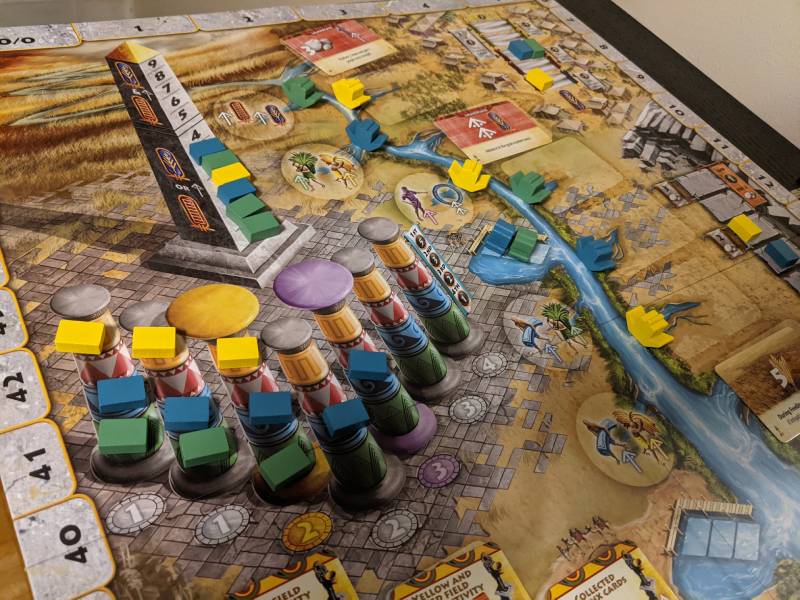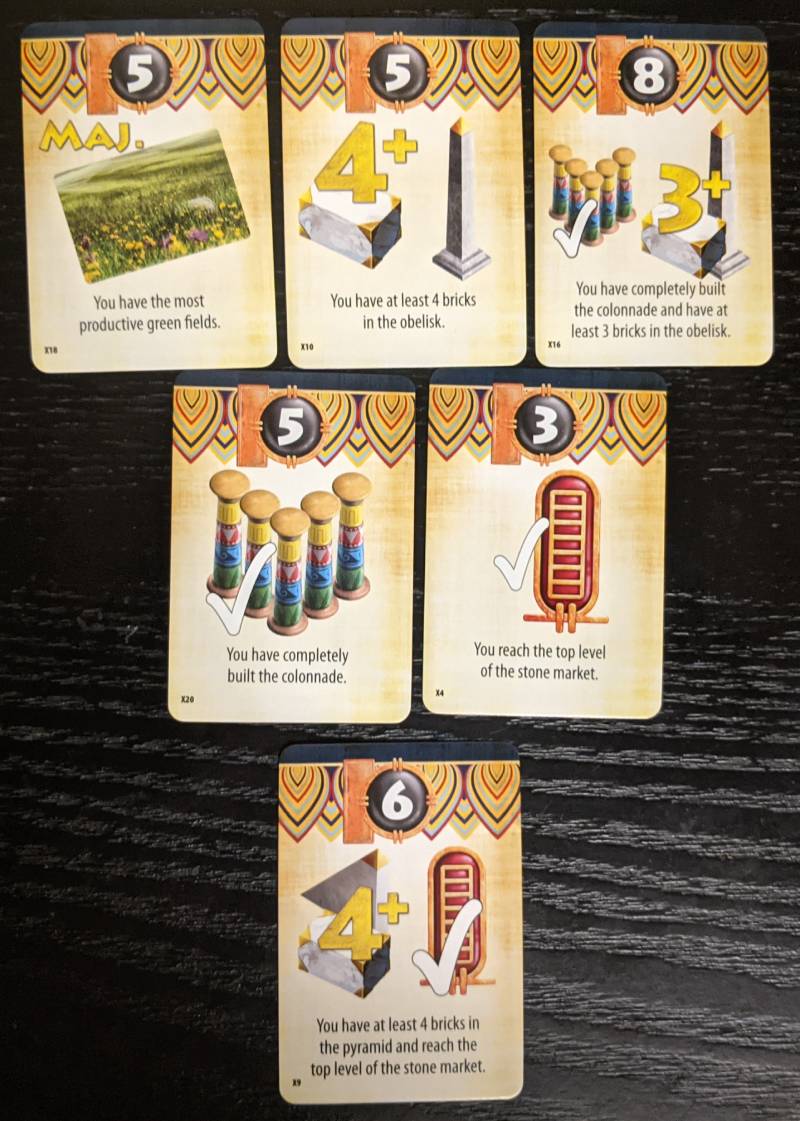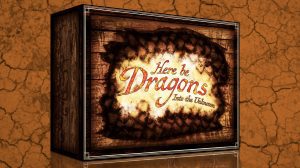When reviewing remastered board games, the reviewer often speaks of the old version and how much they enjoyed it in the first paragraph. They attempt to build their credibility and authenticity at the subject at hand. You won’t find that here because I never played or was aware of the original game’s existence. I’m fresh off the boat here, so why am I reviewing this?
I played this version a few years ago and was intrigued by the premise, but I wasn’t overly excited about it either. My goal was to see how well it would handle a few more sessions. I requested the review copy of Terraforming Mars: Ares Expedition that led to my famous (infamous?) review of it, and Stronghold Games asked if I wanted to review any other games. That’s it.
Egizia: Shifting Sands is about Egypt being Egypt. The Pharaoh wants some monuments to solidify his name throughout history. You and your friends are the best builders in the land, and like any other good capitalist, he will bribe you for your time and labor. After five rounds, the player with the most points wins.

Crafting the blocks
Each player mat shows a basic outline of each round, your crew strength, and your stone stockpile. Next to your board, you will have two cards representing your stone and food production. Throughout the game, you will receive more cards that provide you with additional abilities, fields, and stone production.
Going through a round is almost as straightforward as the player mat itself. A river snakes down from the top to the bottom of the board. Alongside this river, several stops will give you cards, improve the strength of your crew, and change the weather? Egyptian builders were badass. Joking aside, the weather is important because certain fields can only work in specific weather conditions. You are not running an Amazon warehouse here—you need to feed your workers, or you lose points.
Speaking of points, most of them will come from three construction sites located on the river. The first construction site has the Obelisk and Colonnade. With the Obelisk, the players will build this monument together upwards, with the higher parts of the Obelisk requiring more stone and strength. The Colonnade is a literal race and laid out as such as players try to move from the left and to the right as swiftly as possible since you get bonus points for being first to the other side.
The second construction site has the Pyramid and Statues. As you would expect, the Pyramid has players building together starting with the base and moving upwards to the top. The Statues are end-game goals that you can build towards for those sweet extra points.
The final and third construction site is the Sphinx. Here you draw a handful of cards, pick one, and discard the rest. All of these cards are end-game objectives that you do not show to anyone else.
Down by the river
That was a lot of explaining about the board itself, but how do you take your turn? Pick up your wooden boat, place it as far as you like, and immediately do whatever the spot does. If it’s a construction site, you will use it later in the round.
As with any river, this is a one-way trip. You will continue to place other boats once your turn comes up, but you cannot move up, only down. To make it more challenging, each round the spots for increasing your crew or gaining cards are randomized. As a result, turn order is important, and the conflicting values of your opponents drive the game’s tension. As you place your boats, you are constantly looking at your friends. You’ll mentally cross your fingers in hopes that your opponents will not take the spot that you have been eying since the round started. The puzzle has no clear solution while providing an impressive amount of replayability.
If there is one sentence I would use to describe Egizia, it’s this: This game is the best hits record album of euro gaming.
After playing this a few times, I get that late 2000s aftertaste with its design. It was a time where designers didn’t rely on high-end production to blanket over mediocre rules and systems. The act of placing a piece and competing on the scarcity isn’t new to board gaming, but Engizia is one of the few games that do it well.

Friendly competition
Despite its competitiveness and cutthroat nature, I was surprised at the semi-cooperative energy that filled this game’s atmosphere like a swarm of locusts on a bad Tuesday. Most construction sites have players working together to build these monuments, and even the weather itself relies on other players. If you’re playing a four-player game and you are the only one with a potent field for food, expect everyone else to conspire against you to make sure your workers starve. I didn’t say it was a cooperative game under your terms.
Even the randomization is somewhat acceptable here. Besides the river spots having cards, the Statues themselves are different in each game. These Statues are vital because they fertilize the value of certain areas in the game. If the Statues are focused on stone and buildings, expect those areas to be hot spots for the rest of the game.
Although I have praised this game quite a bit, I still didn’t feel the flames of excitement after playing a few times. It goes back to my sentence describing this game as a best hits album. The problem with best hits albums is you’ve heard it all before.
History repeating itself
Going through the rules and mechanisms, I felt like I was taking a pop quiz test of other games. Moving down a path to take actions and can’t go back? I’ve played Tokaido. Construction sites where players compete and co-operate with each other at the same time? Imhotep is a decent game. Food to feed my people? I’ve suffered through Agricola.
You have to realize that most of my feelings are from my personal experience. I’ve been a “serious” board gamer since the early 2000s and have written over 50 reviews since 2020. Calling me a Veteran is an understatement.
Despite my subjective feelings towards this game, I can’t ignore just how well designed it is. The rules make logical sense and are easy to grasp. I am conditioned to accept moon logic rules, and playing this game was a culture shock to me.
To give a quick illustration, let’s talk about stone, food, and workers. You want to build a piece of the Obelisk that is worth five points. How much stone do you need? Five. Strength of crew? Five. How much food is needed to feed that crew? Five. I’m not used to this plainness.
That’s why I was surprised to see this game buried in the board game industry. Sure, it doesn’t do anything drastic or new (what did you expect from a remake of a 2009 game?), but it packages everything with style. It’s intuitive and doesn’t punch your brain for three hours. For the experienced gamer, this one might fall flat. However, this is an easy recommendation for people looking beyond the holy trinity of entry-level games that is Carcassone, Ticket to Ride, and Settlers of Catan.
Just because I said that, doesn’t mean the game isn’t flawless. There are two areas that annoy me.

Noticeable cracks
First, those Sphinx cards. While it sounds interesting that you get these end-game goals in your hand throughout the game, they don’t work well in this context. Since the Statue cards dictate the value of certain areas of the game, you will often draw Sphinx cards that don’t align. The compensation for bad card draws is that you get a point for each card you discard, yet I can’t shake the feeling that I’m playing a 90-minute version of Blackjack. In my last game before this review, the person in last place after revealing the Sphinx cards jumped in front of everyone because they drew the right cards.
The second bit is the awkward attempt for a two-player game. On the reverse side of the main board is the two-player variation. To put it bluntly, it doesn’t work. This is a game where the competition relies on its scarcity. Two players, even with its modified board, doesn’t make it as nearly as interesting as the three or four player games. If you are looking for a two-player game, this isn’t it.
I enjoyed the time I spent with Engizia: Shifting Sands, despite my few complaints. It’s understandable why this game has a following and why a remake was Kickstarted. There is more to like here than to dislike, and it serves as proof why we should preserve the great board games of the past for a new generation of gamers. Egizia: Shifting Sands deserves more recognition from board gamers.












Add Comment